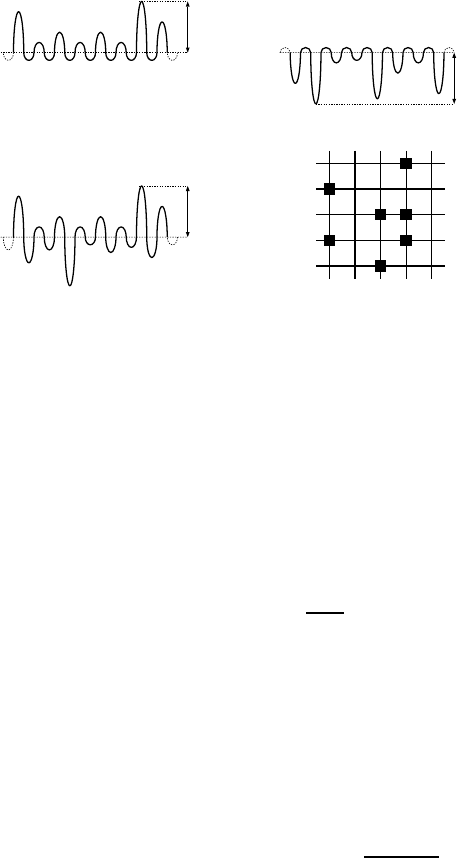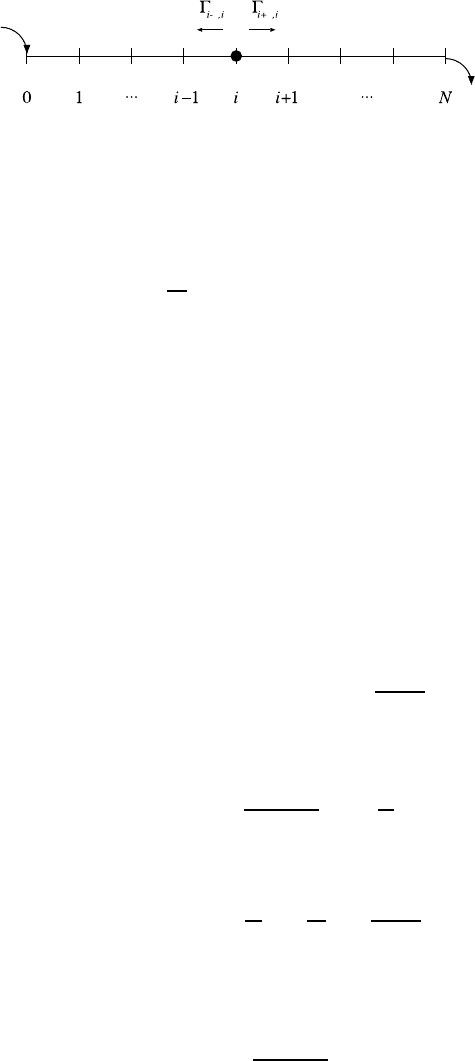Heitjans P., Karger J. (Eds.). Diffusion in Condensed Matter: Methods, Materials, Models
Подождите немного. Документ загружается.


752 Klaus W. Kehr et al.
P (l,t) −→ p(r,t) , (18.23)
where p(r,t)d
d
r is the probability density of finding the particle in the vol-
ume element d
d
r at location r and time t (initial conditions omitted). The
probability density obeys the diffusion equation (Fick’s 2
nd
law)
∂
∂t
p(r,t)=D∇·∇p(r,t), (18.24)
where ∇·∇is the Laplace operator in d dimensions.
18.2.4 Extensions
There are important extensions of the master-equation description of diffu-
sion of a single particle on a regular lattice with uniform transition rates.
– More complicated lattices
Examples are lattices with a basis, e.g. the lattice of tetrahedral sites
of hydrogen in bcc metals. This extension is trivial from the theoretical
point of view, however, the derivation of P(k,t) may require considerable
labour. References are given in [15].
– Lattices with inequivalent sites
Inequivalent sites can occur in lattices with a basis, when some sites in
the unit cell are energetically lower than the others. This leads to a larger
thermal occupation of these sites. The problem of taking the different
thermal occupation factors into account was solved in principle in [22]
and [23], for a review, see [15]. Applications were made by Anderson et
al. [24].
– Two-state models for diffusion and trapping
These models provide a very simple description of trapping processes.
The basis is the decomposition of the conditional probability into a part
corresponding to a free state and a part corresponding to a trapped state,
P
l
(t)=P
free
l
(t)+P
trapped
l
(t) . (18.25)
A particle may be alternatively in a free or a trapped state, with mean
times of stay τ
1
,orτ
0
, respectively. The two-state model can be treated by
differential equations (Schroeder [25]), or by integral equations (Richter
and Springer [26]), with equivalent results. The differential equations are
somewhat more compact and they read
d
dt
P
f
l
(t)=Γ
l
,l
[P
f
l
(t) − P
f
l
(t)]
− Γ
t
P
f
l
(t)+Γ
r
P
t
l
(t)
d
dt
P
t
l
(t)=−Γ
r
P
t
l
(t)+Γ
t
P
f
l
(t), (18.26)

18 Diffusion of Particles on Lattices 753
with the trapping rate Γ
t
=1/τ
1
and the release rate Γ
r
=1/τ
0
. The first
equation in (18.26) is the usual master equation, augmented by a loss
and gain term, corresponding to transitions into and out of the trapped
state. The second equation describes the temporal development of the trap
state. An application of the two-state model has been given in Sect. 3.6
of Chap. 3.
All models mentioned above, and some additional models, for instance
correlated-walk models, have in common that they are lattice-translation
invariant. Hence they are solved by similar techniques as described above.
Spatial Fourier transformation leads to a partial diagonalization, the rest is
the solution of coupled ordinary first-order differential equations. As already
said, this may require considerable effort in complicated cases, but in princi-
ple the solution of these models is understood.
18.3 One Particle on Disordered Lattices
18.3.1 Models of Disorder
In this section the random walk of a single particle, or of independent parti-
cles, on lattices with disordered transition rates will be considered. The main
emphasis of this chapter will be on the derivation of asymptotic diffusion co-
efficients, but also the time dependence of the mean square displacement, or
the frequency dependence of the conductivity will be considered. The models
of disorder will be defined on regular lattices, and topological disorder will
not be included. This is a popular approach for modeling diffusion in disor-
dered materials, even if many materials of interest do not have crystalline
structure. It means that the disorder is put completely into the transition
rates,
Γ −→ Γ
fi
, (18.27)
which depend on the initial (i) and final (f) sites. The rates are assumed to
be fixed, i.e. the case of quenched disorder is treated. In principle, one could
include transitions between arbitrary sites, in practice only nearest-neighbour
transitions are taken into account, as is appropriate for diffusion of atoms.
Various models of disorder have been introduced in different contexts.
Here some idealized models of disorder will be considered:
– Random barriers (RB)
In this model the transition rates between neighbour sites have the sym-
metry
Γ
ji
= Γ
ij
. (18.28)
It is usually assumed that the rates are given by an Arrhenius law,
Γ
ji
= Γ
0
exp
−
E
ji
k
B
T
E
ji
≥ 0 . (18.29)

754 Klaus W. Kehr et al.
E
i,i+1
i i+1i-1
E
i
i
i+1
i-1
E
i,i+1
i i+1i-1
(a) (b)
(c)
(d)
Fig. 18.2. Models of disorder.
The disorder then originates from random barrier energies E
ji
,whichare
taken from a distribution ν
B
(E). A pictorial representation of the RB
model is given in Fig. 18.2(a).
– Random site energies (RT)
Another important model is the random site-energy model, which is also
called random-trap model. One should keep in mind that the traps do
not capture the particles permanently. The model is defined by transition
rates that depend on the initial sites, but not on the final sites,
Γ
ji
= Γ
0
exp
E
i
k
B
T
E
i
≤ 0 . (18.30)
The site energies E
i
are counted negative and they are taken from a
distribution ν
T
(E). A pictorial representation of the RT model is given
in Fig. 18.2(b).
– Combination of RB and RT
In this chapter also a combination of random barriers and random site
energies will be studied. The rates of the combined RB and RT model
shall be given by
Γ
ji
= Γ
0
exp
−
E
ji
− E
i
k
B
T
. (18.31)
The random-barrier energies E
ji
and the random-site energies E
i
are
taken independently from the distributions ν
B
(E)andν
T
(E). A picto-
rial representation of the model is given in Fig. 18.2(c). Note that all
energies refer to a common origin E =0.
18 Diffusion of Particles on Lattices 755
– Randomly blocked sites (RBS)
Finally, the model of randomly blocked sites will be included in this list of
models of disorder. Sites of a lattice are randomly blocked with probability
1 − p and not accessible to the particle that performs random walk. The
transition rates of this model are defined by
Γ
ji
=
Γ if j is “open”
0ifj is blocked.
(18.32)
The pictorial representation of the model is included in Fig. 18.2(d). Of
course, this model is nothing else than the site percolation model, which is
exclusively treated in Chap. 22. In the present chapter, however, the RBS
model will only be considered for concentrations p of open sites above the
percolation threshold, where long-range diffusion of a particle is possible.
There are other models with disordered transition rates which are not in-
cluded in the list above. One example is the Miller-Abrahams model, where
transitions that lead to sites with lower energies have rates that do not depend
on the energy difference, while the transitions to sites with higher energies re-
quire thermal activation. For a treatment of this model with similar methods
as applied here the reader is referred to [29].
18.3.2 Exact Expression for the Diffusion Coefficient in d =1
It is possible to give an exact expression for the diffusion coefficient of a
particle in a linear chain for rather general disordered rates. Some restrictions
on the disorder have to be made, which will be explained below. Linear chains
with sites at a distance a will be considered and one may view Fig. 18.2(c) as a
graphical representation of such a model. The task is to derive the asymptotic,
long-time diffusion coefficient of a particle, averaged over the disorder.
The expression to be given below was derived independently by Dieterich
[27] and Kutner [28], and by Wichmann [29]. Dieterich and Kutner calculated
the mobility of a particle from the linear response to a force while Wichmann
used a mean first-passage time method. Here a derivation will be given which
utilizes Fick’s first law. Of course, there are relations between the different
derivations.
Consider a finite chain of length Na, as schematically displayed in
Fig. 18.3. A particle current I (precisely: probability current) into site 0
is assumed such that P
0
is fixed. The same particle (probability) current is
then taken out at site N and a stationary situation is maintained.
The derivation for general disorder is somewhat tedious and hence put into
the appendix. A much simpler derivation can be made for the random-barrier
model with Γ
i+1,i
= Γ
i,i+1
and it should convey the idea of the derivation.
Consider Kirchhoff’s node equation for site 0 which expresses the fact
that the sum of all currents into the site must be zero:

756 Klaus W. Kehr et al.
I
I
11
Fig. 18.3. Linear chain with constant current I.
I + Γ
10
(P
1
− P
0
)=0. (18.33)
The master equation at site 1 reads
d
dt
P
1
= Γ
10
(P
0
− P
1
)+Γ
21
(P
2
− P
1
) . (18.34)
One finds in the stationary situation
Γ
21
(P
1
− P
2
)=Γ
10
(P
0
− P
1
)=I, (18.35)
where also (18.33) was used. The same consideration yields for all sites
0 ≤ i<N
Γ
i+1,i
(P
i
− P
i+1
)=I. (18.36)
One can now play the following trick: Write
P
0
− P
N
= P
0
− P
1
+ P
1
− P
2
+ P
2
∓ ...
−P
N−1
+ P
N−1
− P
N
. (18.37)
Introduce the current I into the differences by using (18.36),
P
0
− P
N
= I
%
N−1
i=0
1
Γ
i+1,i
'
. (18.38)
This expression is already Fick’s first law. To recognize this, rewrite (18.38)
as
P
0
− P
N
N
= I
1
Γ
, (18.39)
where the sum has been replaced by the disorder average (valid for large N)
1
Γ
=
1
N
N−1
i=0
1
Γ
i+1,i
. (18.40)
The length of the chain is Na and the probability density at site i is P
i
/a.
Hence one can identify the gradient of the probability density,
P
0
− P
N
Na
2
= −∇n. (18.41)

18 Diffusion of Particles on Lattices 757
Fick’s first law reads I = −D∇n. Comparison with the above expressions
yields
D =
1
Γ
−1
a
2
. (18.42)
The expression (18.42) is the exact result for the diffusion coefficient of the
RB model in d = 1, which is known since a long time [13].
The physical significance of the result is that the highest barriers dominate
diffusion in d = 1. This is evident: particles have to overcome all barriers in
the course of long-range diffusion, and it takes long times to overcome the
high barriers.
The generalization of the result to arbitrarily disordered transition rates
is
D =
1
Γ
i+1,i
ρ
i
−1
a
2
, (18.43)
with the thermal occupation factors
ρ
i
=
exp(−βE
i
)
1
N
N−1
j=0
exp(−βE
j
)
, (18.44)
where β =1/(k
B
T ). The existence of the thermal occupation factors ρ
i
is
required in the proof, which is given in the appendix. The ρ
i
exist when
one can introduce a reference energy E
0
and the sum in the denominator of
(18.44) remains finite for arbitrary N. A counterexample, where the ρ
i
do
not exist in the limit N →∞will be given in Sect. 18.3.7.
The expression (18.43) for the diffusion coefficient of a particle on a linear
chain with general disorder means that one has to use transition rates that
are weighted by the mean thermal occupation of the sites. This is an exact
result in d = 1 (see [27–29]).
18.3.3 Applications of the Exact Result
The expression (18.43) for the diffusion coefficient in d = 1 will now be
examined for the models that have been introduced in Sect. 18.3.1. Henceforth
the lattice constant will be set a =1.
For the random barrier model, where Γ
i,i+1
= Γ
i+1,i
one has ρ
i
=1.The
result (18.42) is then immediately obtained from (18.43) and it is the correct
result in d =1.
In the random site-energy model, where Γ
ji
= Γ
0
exp(βE
i
), the product
is
Γ
ji
ρ
i
= Γ
0
⎡
⎣
1
N
j
exp(−βE
j
)
⎤
⎦
−1
. (18.45)
Hence the diffusion coefficient is given by

758 Klaus W. Kehr et al.
D =
Γ
0
1
N
j
exp(−βE
j
)
. (18.46)
This is the exact result in d = 1; it is also valid in all dimensions [15, 30].
Normally it is written in the form D = {
1
Γ
}
−1
which is equivalent to (18.46).
Equation (18.46) signifies that the diffusion coefficient of the RT model is
solely determined by the inverse of a partition function, which becomes large
for strong site-energy disorder and/or low temperatures.
An immediate consequence of the exact expression (18.46) for the diffusion
coefficient of the RT model is its downward curvature in an Arrhenius plot,
where ln D is displayed as a function of β =1/k
B
T . Differentiating ln D
according to (18.46) with respect to β one obtains
∂ ln D
∂β
=
j
E
j
exp(−βE
j
)
j
exp(−βE
j
)
= E . (18.47)
Thus the slope of the Arrhenius plot of D is the mean thermal energy of a
particle in the RT model. The mean thermal energy decreases with increasing
β in the case of energetic disorder, hence one has convex (downward) curva-
ture of D(β) in the Arrhenius plot. This is the generic cause for downward
curvature of D(β) in the Arrhenius plot.
Finally the combined RB and RT model will be considered. The rates of
this model were given in (18.31). The weighted rates are then
Γ
ji
ρ
i
= Γ
0
⎡
⎣
1
N
j
exp(−βE
j
)
⎤
⎦
−1
exp(−βE
ji
) . (18.48)
One obtains for independent distributions of barrier and site energies [31]
D
comb
=
1
Γ
0
D
RB
D
RT
. (18.49)
Thus the diffusion coefficient of this model factorizes into two independent
contributions in d = 1. A numerical verification of the result is given in
Fig. 18.4.
18.3.4 Frequency Dependence in d = 1: Effective-Medium
Approximation
Not only the asymptotic behaviour of the mean square displacement is of
interest, but also the behaviour at finite times. It corresponds to the frequency
dependence of the mobility. Asymptotic expansions of the time-dependent
mean square displacement were made for the RB and RT models; they yield
exact results in d = 1 for the RB model and all d for the RT model [32, 33].
Here an approximate treatment will be introduced for several reasons:

18 Diffusion of Particles on Lattices 759
-4
-2
0
0 0.5 1 1.5
ln(D)
1/T
Fig. 18.4. Diffusion coefficient in combined RB and RT model. Uniform distribu-
tions of barriers and site energies of width E
c
= 2. Line: Equation (18.48); symbols:
Monte Carlo (MC) simulations.
i) The technique is rather simple and intuitive.
ii) The approximation yields an overall description of the frequency-dependent
mobility.
iii) It is easily generalized to higher dimensions.
To formulate the effective-medium approximation (EMA), the random barrier
model will be considered in d = 1. The master equation reads
d
dt
P
i
(t)=Γ
i,i+1
[P
i+1
(t) − P
i
(t)]
+Γ
i,i−1
[P
i−1
(t) − P
i
(t)] . (18.50)
The rates Γ
i,i±1
are taken from a common distribution ρ(Γ ) (or, equivalently,
are determined from the distribution of barrier energies).
The frequency-dependent formulation of the EMA was developed by sev-
eral authors around 1980 (Alexander and Orbach [34], Summerfield [35],
Odagaki and Lax [36], Webman [37]). Here a derivation by an embedding
procedure will be given, following Haus et al. [38]. One systematic, random
transition rate Γ
01
is embedded in a linear chain, which consists of time-
dependent, effective transition rates. A graphical representation is given by
Fig. 18.5 (bottom).
The systematic rate is taken from the distribution ρ(Γ ) and, once selected,
considered as fixed.
The master equations for the conditional probabilities P
i
(t)forsitesthat
do not involve sites 0 and 1 are
d
dt
P
i
(t)=
t
0
dt
Γ
eff
(t − t
)[P
i+1
(t
)+P
i−1
(t
) − 2P
i
(t
)] . (18.51)
The master equation for the conditional probabilities P
0
and P
1
is then

760 Klaus W. Kehr et al.
eff
Fig. 18.5. Embedding procedure for
effective-medium approximation.
d
dt
P
0
=
t
0
dt
Γ
eff
(t − t
)[P
−1
(t
) − P
0
(t
)]
+ Γ
01
[P
1
(t) − P
0
(t)] ,
d
dt
P
1
= Γ
01
[P
0
(t) − P
1
(t)]
+
t
0
dt
Γ
eff
(t − t
)[P
2
(t
) − P
1
(t
)] . (18.52)
This set of master equations will be compared with the master equation for
the effective medium only, where the conditional probability will be called
E
i
(t) (see also Fig. 18.5 (top))
d
dt
E
i
(t)=
t
0
dt
Γ
eff
(t − t
)[E
i+1
(t
)+E
i−1
(t
) − 2E
i
(t
)] . (18.53)
Now a Fourier and Laplace transformation of both equations will be made.
The Laplace transform of a function f(t) is defined by
˜
f(s)=
∞
0
dtE
−st
f(t) . (18.54)
The advantage of the Laplace transformation is that the initial condition of
the master equations appears explicitly, because
∞
0
dte
−st
df(t)
dt
= e
−st
f(t) |
∞
0
+s
∞
0
dte
−st
f(t)
= s
˜
f(s) − f(t =0). (18.55)
The master equation for the effective medium reads after the transformations
[s +2Γ
eff
(s)(1 − cos ka)]
˜
E(k, s)=1. (18.56)
The 1 on the right-hand side of the equation comes from the initial condition
E
i
(t =0)=δ
i,0
.

18 Diffusion of Particles on Lattices 761
It is possible to solve the equations for
˜
P
0
(s)and
˜
P
1
(s), as explicitly
shown in the appendix. The requirement will be made that the average over
the different realizations of the embedded bond will reproduce the effective
medium. Hence the requirement is
{
˜
P
0
(s)}
ρ(Γ )
=
˜
E
0
(s) . (18.57)
Equation (18.57) is a self-consistency condition for
˜
Γ
eff
(s). In the appendix
the following explicit form of the self-consistency condition is derived,
˜
Γ
eff
(s) − Γ
10
Γ
1,0
+ s
˜
E
0
(s)[
˜
Γ
eff
(s) − Γ
10
]
ρ(Γ
10
)
=0. (18.58)
The conditional probability of the effective medium at site 0 can be given
explicitly in d =1,
˜
E
0
(s)=[s(s +4
˜
Γ
eff
(s))]
−1/2
. (18.59)
The self-consistency condition (18.58) corresponds to a fourth-order equation
whose general solution is of no practical use. Hence an ansatz is made to
determine Γ
eff
(s) for small s, corresponding to long times,
Γ
eff
(s)=Γ
eff
(1 + ϑ
1
(s/Γ
eff
)
1/2
+ ···) s −→ 0 . (18.60)
The self-consistency condition yields
Γ
eff
=
1
Γ
−1
(18.61)
and
ϑ
1
=
1
2
Γ
2
eff
1
Γ
−
1
Γ
eff
2
. (18.62)
The results for Γ
eff
and ϑ
1
are exact [32]; note that ϑ
1
is specific for the
presence of disorder.
Having obtained the effective transition rate for small s, one can deduce
the asymptotic mean square displacement of a particle by an extension of the
procedure of Sect. 18.2.3. The result for the disorder-averaged mean square
displacement is
{δx
2
}(t)=2Γ
eff
a
2
t +2ϑ
1
(t/πΓ
eff
)
1/2
+ ···
. (18.63)
There appears a “long-time tail” correction to the asymptotic mean square
displacement. Note that (18.63) together with (18.61) reproduces the exact
result (18.42) of the RB model, which was derived earlier.
The result for the s-dependence of the effective transition rate gives also
information on the frequency dependence of the mobility. The frequency-
dependent mobility of a particle is obtained from the linear response to a
